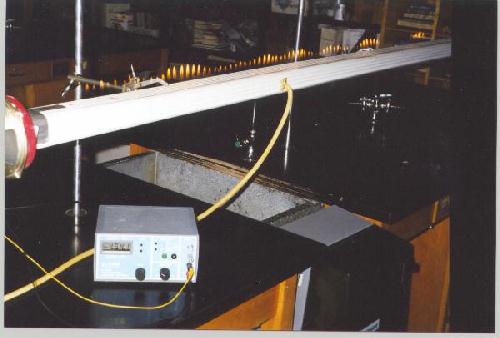
Special Problems: A collection from various sources.
Waves, Sound
1. Transverse seismic waves, or S-waves, travel through the mantle of the earth but are unable to pass through the molten core. Thus they arrive after the P-wave (push-pull waves) which are longitudinal waves. If an S-wave travels at 8 km/s with a frequency of 2 Hz, what is the wavelength?
2. A youngster in a boat watches waves on a lake passing with a half-second pause between each crest. If one wave takes 1.5 s to sweep straight down the length of her 4.5 m boat, what is the velocity, frequency, period, and wavelength of the waves?
3. Dolphins operate underwater by using compression waves with high frequencies. If the speed of sound in water is 1.4 x 103 m/s and the average wavelength is 1.4 cm, what is the typical frequency of a dolphin's speech? Is this frequency audible to humans?
4. While heading for a moth, a horseshoe bat emits a stream of ultrasonic wavetrains having a frequency of 83 kHz, each lasting 5 milliseconds. Given the speed of sound as 340 m/s, determine the length of a single wavetrain. What is the wavelength of one wave?
5. The human chest cavity resonates at around 8 Hz. What wavelength of sound would cause such a vibration?
6. By international agreement, most orchestras tune to a frequency of 440 Hz, which is called A440. Given the speed of sound in air at room temperature is 349.9 m/s, what is the wavelength of A440?
7. On a touch-tone phone, pressing "7" causes the superposition of two frequencies, 852 Hz and 1209 Hz. If total destructive interference occurs at 0.5, 1.0, 1.5, 2.0, 2.5, etc. multiples of the wavelength ratios, do these waves cancel?
8. Helium allows sound to travel at 970 m/s. Explain the effect one hears in the voice upon exhaling helium.
9. Kathleen Battle, a well-known soprano, often reaches frequencies of 1100 Hz during a performance at the Metropolitan Opera House. Placido Domingo, one of the "three tenors," often reaches 150 Hz? What is the range in wavelengths between these two virtuosos?
Extra Credit (assuming all other work is in): you must show specifics!
1. Extracorporeal shock wave lithotripsy (ESWL)
2. Write a report on the acoustic reflex that protects your hearing.
3. How does a siren work on a fire truck? (how did "siren" get its name?)
4. Who invented the tuning fork? (Hint: he was lead trumpet for Handel) (only 1 point)
5. Write a report on the specifics of ultrasound waves used in medical diagnoses.
6. Echolocation in chiroptera.
Seeing Sound Demonstration (This demonstration must be performed only by qualified personnel. For additional details, please contact J. Keefer.)
Notice how the natural gas varys in color and amplitude. As the frequency of the speaker on the left is varied, nodes and antinodes are established along the length of the downspout. This allows for the visual measurement of the longitudinal wavelength of sound (seeing sound!).

Sincere thanks to Dr. Robert Greenler (Physics Department at the University of Wisconsin-Milwaukee) for the idea of seeing sound. This demonstration was adapted from a Science Bag presentation at UW-Milwaukee.
Back to the Brockport High School Science Department